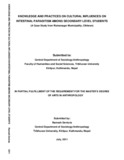Please use this identifier to cite or link to this item:
https://elibrary.tucl.edu.np/handle/123456789/2745| Title: | Knowledge and Practices on Cultural Influences on Intestinal Parasitism among Secondary Level Students (A Case Study from Ratnanagar Municipality, Chitwan) |
| Authors: | Devkota, Ramesh |
| Keywords: | Knowledge;Students;Study |
| Issue Date: | 2011 |
| Publisher: | Central Department of Sociology and Anthropology |
| Abstract: | This study was designed to determine the knowledge of secondary level students’ on daily human practices and their influences in human parasitic infections. One hundred ten male and female secondary level students from two secondary schools of Ratnanagar municipality were asked to fill a questionnaire to determine their knowledge on cultural influences in human parasitic infections. Out of total 110 respondents, 30 percent were below 15 years and 70 percent were between 15 and 19 years of age. Around 51 percent of them were from Brahmin community followed by Chhetri (15%), Newar (11%), Tharu (10%), other groups (8%), Tamang (4%) and Gurung (2%). Among the total respondents 86 percent were Hindu followed by Buddhist (6%), Christian (3%), Muslim (2%) and others (3%). 92 percent respondents’ fathers and around 87 percent mothers were literate. Based on occupational status, around 36 percent of the respondents were from agriculture background followed by business, private employee and others occupation. Majority of the respondents’ (43%) mothers were engaged in agriculture and least proportion (1%) mothers were engaged in government employment. Among male respondents all have electricity followed by TV, radio, phone, computer and e-mail/internet. Similarly, among females all have electricity followed by TV, phone, radio, computer and e-mail/internet. Of the total 110 stool samples tested, 43 (39.1%) were found positive for parasites with highest prevalence in females. The most prevalent parasite was Giardia lamblia followed by Trichuris trichura, Ascaris lumbricoides, Entamoeba histolytica, hook worm and E. coli with co-infection of round worm and E. histolytica. Out of 110 respondents, most (98.2 %) had heard about the parasites. About 76 percent of them had heard about Malaria parasites followed by Hookworms, Tape worms, Liver flukes, Round worm, Whip worm and Others. Majority of them had obtained knowledge on parasites from text books. Around 45 percent of the respondents said that parasites were very harmful followed by harmful (43.5%), neither harmful nor useful (6.5%) and don’t know (4.6%). 25 percent respondents said that drinking contaminated water was the most potential source of parasite transmission followed by walking bare foot, eating contaminated food, close companion with domestic animals, swimming /washing or fishing in polluted water and don’t know. Around 22 percent of the respondents said that wash hand before eating and after toilet is the most important preventive method of parasitic transmission followed by proper use of latrine, avoid walking bare food, protect food from house flies or other insects, do not eat contaminated food, do not drink contaminated water, washing fruits and vegetables before eating and don’t know. Children were the most vulnerable age group and farmers were the most risk occupational group of parasitic infection. All of the respondents have latrines at their home and all of them use it properly. 79 percent of the respondents claimed that their family members have no parasitic infection in the past six months. In conclusion the female respondents in spite of having higher knowledge on parasitic infection have higher parasitic load. The age of the respondents’ have some role to determine the respondents’ knowledge on parasites but religion, caste and parents’ educational and occupational status have no role in determining the knowledge of respondents’ on parasites. |
| URI: | http://elibrary.tucl.edu.np/handle/123456789/2745 |
| Appears in Collections: | Sociology |
Files in This Item:
| File | Description | Size | Format | |
|---|---|---|---|---|
| Cover.pdf | 36.19 kB | Adobe PDF |  View/Open | |
| Chapter.pdf | 366.86 kB | Adobe PDF |  View/Open |
Items in DSpace are protected by copyright, with all rights reserved, unless otherwise indicated.
